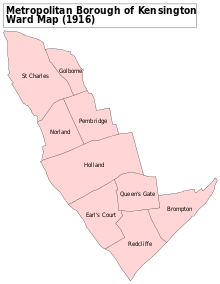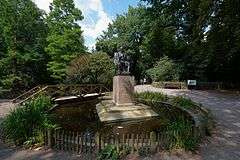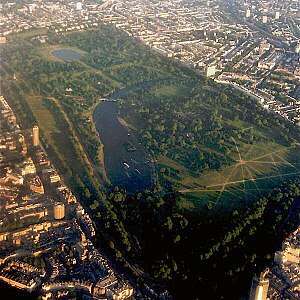Holland Park
Holland Park is an area of Kensington, on the western edge of Central London,[1] that contains a street and public park of the same name. It has no official boundaries but is roughly bounded by Kensington High Street to the south, Holland Road to the west, Holland Park Avenue to the north, and Kensington Church Street to the east. Adjacent districts are Notting Hill to the north, Earl's Court to the south, and Shepherd's Bush to the northwest.
The area is principally composed of tree-lined streets with large Victorian townhouses, and contains many shops, cultural tourist attractions such as the Design Museum, luxury spas, hotels, and restaurants, as well as the embassies of several countries. The street of Holland Park is formed from three linked roads constructed between 1860 and 1880 in projects of master builders William and Francis Radford, who were contracted to build and built over 200 houses in the area. Notable nineteenth-century residential developments in the area include the Royal Crescent and Aubrey House.
History

The district was rural until the 19th century, and most of the area now referred to by the name Holland Park was formerly the grounds of a Jacobean mansion called Holland House. In the later decades of that century the owners of the house sold off the more outlying parts of its grounds for residential development, and the district which evolved took its name from the house. It also included some small areas around the fringes which had never been part of the grounds of Holland House, notably the Phillimore Estate (there are at least four roads with the word Phillimore in their name) and the Campden Hill Square area.
In the late 19th century a number of notable artists (including Frederic Leighton, P.R.A. and Val Prinsep) and art collectors lived in the area, known as the Holland Park Circle.
The public park
- Peacocks in Holland Park
 The formal gardens
The formal gardens.jpg) Formal gardens, looking towards Holland House
Formal gardens, looking towards Holland House The Kyoto Garden
The Kyoto Garden- Kyoto Garden waterfall
The park covers about 22 hectares (54 acres),[2] with a northern half of semi-wild woodland, central section of formal garden areas, and southernmost section used for sport.
Holland House is now a fragmentary ruin, having been devastated by incendiary bombing during the Second World War in 1940, but the ruins and the grounds were bought by London County Council in 1952 from the last private owner, the 6th Earl of Ilchester.[3] Today the remains of the house form a backdrop for the open air Holland Park Theatre, which is the home of Opera Holland Park. To the immediate south of the park is the former site of the Commonwealth Institute, now home to the Design Museum.
The park contains a café, as well as the Belvedere Restaurant that is attached to the orangery, a giant chess set,[4] a cricket pitch, tennis courts, two Japanese gardens - the Kyoto Garden (1991) and Fukushima Memorial Garden (2012),[5] a youth hostel, a children's playground, squirrels and peacocks. In 2010, the park set aside a section for pigs whose job was to reclaim the area from nettles etc., in order to create another meadow area for wild flowers and fauna. Cattle were used subsequently to similar effect.
The Holland Park Ecology Centre (2013), operated by the borough's Ecology Service, offers environmental education programs including nature walks, talks, programs for schools and outdoor activity programs for children.
References
- "Policy 2.5 Sub-regions". The London Plan. Greater London Authority. 2016. Retrieved 13 March 2019.
- "Parks & Gardens UK Holland Park, Kensington, England". web page. Copyright Parks and Gardens Data Services Ltd. 2012. Retrieved 28 January 2013.
- "Archived copy". Archived from the original on 26 February 2012. Retrieved 27 September 2009.CS1 maint: archived copy as title (link)
- "Making mates on giant chessboard in Holland Park | News". Thisislondon.co.uk. 1 November 2010. Retrieved 25 September 2011.
- Pylant, Don. "Holland Park's Fukushima Garden – London | Japanese Gardening". Retrieved 8 July 2019.
External links
| Wikimedia Commons has media related to Holland Park (district). |
- Map of Holland Park - the word "Kensington" is printed across the middle of Holland Park. Kensington is a large district and Holland Park is a subsection of it. The heart of London is off the map to the right.
- The local council's page on the park
- Friends of Holland Park
- Opera Holland Park
- Holland Park Chess



